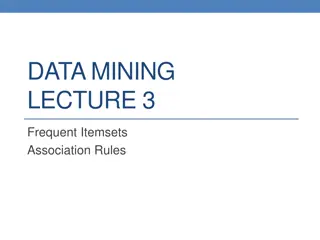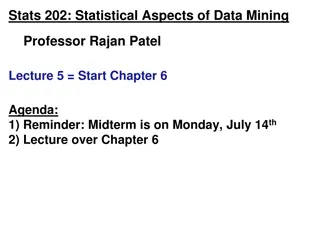Understanding Frequent Itemset Mining for Data Analysis
Frequent itemset mining is a crucial data analysis task with various applications. This article delves into the challenges of dealing with large numbers of frequent itemsets and explores solutions to uncover concise representations, such as maximal, closed, and generator itemsets. The discussion covers transaction databases, support values, and the identification of both frequent and infrequent itemsets.
Download Presentation

Please find below an Image/Link to download the presentation.
The content on the website is provided AS IS for your information and personal use only. It may not be sold, licensed, or shared on other websites without obtaining consent from the author. Download presentation by click this link. If you encounter any issues during the download, it is possible that the publisher has removed the file from their server.
E N D
Presentation Transcript
Maximal, Closed and Generator Itemsets Philippe Fournier-Viger http://www.philippe-Fournier-viger.com Source code and datasets available in the SPMF library 1
Introduction In previous videos, we talked about frequent itemset mining. It is a data analysis task that has many applications. However, a problem is that the number of frequent itemsets is often very large. Besides, frequent itemsets often have some form of redundancy. Today, we will talk about this problem and a solution, which is to discover concise representations of frequent itemsets. 2
Frequent itemset mining Input: A transaction database Transaction Items appearing in the transaction T1 T2 T3 T4 {pasta, lemon, bread, orange} {pasta, lemon} {pasta, orange, cake} {pasta, lemon, orange cake} minsup= 2
Frequent itemset mining Input: A transaction database Transaction Items appearing in the transaction T1 T2 T3 T4 {pasta, lemon, bread, orange} {pasta, lemon} {pasta, orange, cake} {pasta, lemon, orange cake} minsup= 2 Output: The frequent itemsets {lemon}, {pasta}, {orange}, {cake}, {lemon, pasta}, {lemon, orange}, {pasta, orange}, {pasta, cake}, {orange, cake}, {lemon, pasta, orange}, {pasta, orange, cake}
Frequent itemsets {pasta} {lemon} {orange} {cake} support = 4 support = 3 support = 3 support = 2 {pasta, lemon} {pasta, orange} {pasta, cake} {lemon, orange} {orange, cake} support: 3 support: 3 support: 2 support: 2 support: 2 {pasta, lemon, orange} {pasta, orange, cake} support: 2 support: 2 5
Frequent itemsets {pasta} {lemon} {orange} {cake} support = 4 support = 3 support = 3 support = 2 {pasta, lemon} {pasta, orange} {pasta, cake} {lemon, orange} {orange, cake} support: 3 support: 3 support: 2 support: 2 support: 2 There are 10 frequent itemsets! {pasta, lemon, orange} {pasta, orange, cake} support: 2 support: 2 6
minsup =2 The frequent itemsets l p b o c frequent itemsets lb lo lc pb lp po pc bo bc oc pbc poc boc lpb lpo lpc lbo lbc loc pbo l = lemon p = pasta b = bread 0 = orange c = cake Infrequent itemsets lpbo lboc lpbc lpoc pboc lpboc 7
minsup =2 The frequent itemsets l p b o c frequent itemsets lb lo lc pb lp po pc bo bc oc pbc poc boc lpb lpo lpc lbo lbc loc pbo l = lemon p = pasta b = bread 0 = orange c = cake Infrequent itemsets lpbo lboc lpbc lpoc pboc We can observe that if an itemset is frequent then all its subsets are frequent lpboc 8
minsup =2 The frequent itemsets l p b o c frequent itemsets lb lo lc pb lp po pc bo bc oc pbc poc boc lpb lpo lpc lbo lbc loc pbo l = lemon p = pasta b = bread 0 = orange c = cake Infrequent itemsets lpbo lboc lpbc lpoc pboc We call the largest frequent itemsets the maximal frequent itemsets lpboc 9
minsup =2 The frequent itemsets l p b o c frequent itemsets lb lo lc pb lp po pc bo bc oc pbc poc boc lpb lpo lpc lbo lbc loc pbo l = lemon p = pasta b = bread 0 = orange c = cake Infrequent itemsets Maximal frequent itemsets are interesting because if we find them, we can recover all the other frequent itemsets. lpbo lboc lpbc lpoc pboc lpboc 10
Recovering all frequent itemsets Definition: A frequent itemset? is maximal if there is no frequent itemset ? such that ? ?. In this example (minsup = 2), there are only two maximal itemsets: {pasta, lemon, orange} {pasta, orange, cake} support: 2 support: 2 11
Maximal frequent itemsets Definition: A frequent itemset? is maximal if there is no frequent itemset ? such that ? ?. In this example (minsup = 2), there are only two maximal itemsets: {pasta, lemon, orange} {pasta, orange, cake} support: 2 support: 2 We can recover all other frequent itemsets from the maximal itemsets by simply enumerating their subsets: 12
Maximal frequent itemsets Definition: A frequent itemset? is maximal if there is no frequent itemset ? such that ? ?. In this example (minsup = 2), there are only two maximal itemsets: {pasta, lemon, orange} {pasta, orange, cake} support: 2 support: 2 We can recover all other frequent itemsets from the maximal itemsets by simply enumerating their subsets: {lemon}, {pasta}, {orange}, {cake}, {lemon, pasta}, {lemon, orange}, {pasta, orange}, {pasta, cake}, {orange, cake}, 13
Maximal frequent itemsets Definition: A frequent itemset? is maximal if there is no frequent itemset ? such that ? ?. In this example (minsup = 2), there are only two maximal itemsets: {pasta, lemon, orange} {pasta, orange, cake} support: 2 support: 2 We can recover all other frequent itemsets from the maximal itemsets by simply enumerating their subsets: {lemon}, {pasta}, {orange}, {cake}, {lemon, pasta}, {lemon, orange}, {pasta, orange}, {pasta, cake}, {orange, cake}, But we cannot recover their support! 14
Maximal itemsets are compact If we find the maximal frequent itemsets, we can find much less itemsets. Example: Chess dataset and minsup =0.4 6,439,702 frequent itemsets 38,050 frequent maximal itemsets 168 times smaller 15
How to find the maximal itemsets? Na ve approach by post-processing inefficient! Efficient algorithms: GenMax: a modified version of ECLAT FPMax: a modified version of FP-Growth LCMMax: a modified version of LCM and many others! Those algorithms adopt various strategies to find the maximal itemsets without having to find all frequent itemsets. 16
What are the alternatives? Is there some other ways of summarizing the frequent itemsets? Another popular representation of frequent itemsets is the closed itemsets (Pasquier et al., 1999) 17
Could we do better? Is there some other ways of summarizing the frequent itemsets? Another popular representation of frequent itemsets is the closed itemsets (Pasquier et al., 1999) Definition: A (frequent) itemset? is closed if there exists no (frequent) itemset ? such that ? ? and sup(?) = sup(Y). 18
Closed itemsets {pasta} {lemon} {orange} {cake} {pasta, lemon} {pasta, orange} {pasta, cake} {lemon, orange} {orange, cake} {pasta, lemon, orange} {pasta, orange, cake} support = 4 closed support = 3 support = 3 support = 2 support: 3 support: 3 support: 2 support: 2 support: 2 support: 2 support: 2 closed closed closed closed 19
minsup =2 The frequent closed itemsets 4 minsup = 2 3 4 3 2 l p b o c frequent itemsets 3 2 3 2 2 lb lo lc pb lp po pc bo bc oc 2 2 pbc poc boc lpb lpo lpc lbo lbc loc pbo infrequent itemsets lpbo lboc lpbc lpoc pboc support frequent non closed itemsets frequent closed itemsets lpboc 20
Closed itemsets are compact Example: Chess dataset and minsup =0.4 6,439,702 frequent itemsets 1,361,157 frequent closed itemsets 38,050 frequent maximal itemsets
Recovering all frequent itemsets Definition: A (frequent) itemset? is closed if there exists no (frequent) itemset ? such that ? ? and sup(?) = sup(Y). In this example (minsup = 2), there are only five closed itemsets: {pasta} {pasta, lemon} {pasta, orange} {pasta, lemon, orange} {pasta, orange, cake} support = 4 support: 3 support: 3 support: 2 support: 2 closed closed closed closed closed 22
Recovering all frequent itemsets Definition: A (frequent) itemset? is closed if there exists no (frequent) itemset ? such that ? ? and sup(?) = sup(Y). In this example (minsup = 2), there are only five closed itemsets: {pasta} {pasta, lemon} {pasta, orange} {pasta, lemon, orange} {pasta, orange, cake} support = 4 support: 3 support: 3 support: 2 support: 2 closed closed closed closed closed By enumerating all their subsets, we can find all the other frequent itemsets: {pasta, cake}, {lemon, orange}, {orange, cake}, {lemon,{orange} ,{cake} 23
Recovering all frequent itemsets Definition: A (frequent) itemset? is closed if there exists no (frequent) itemset ? such that ? ? and sup(?) = sup(Y). In this example (minsup = 2), there are only five closed itemsets: {pasta} {pasta, lemon} {pasta, orange} {pasta, lemon, orange} {pasta, orange, cake} support = 4 support: 3 support: 3 support: 2 support: 2 closed closed closed closed closed By enumerating all their subsets, we can find all the other frequent itemsets: {pasta, cake}, {lemon, orange}, {orange, cake}, {lemon,{orange} ,{cake} But how to find the support of these itemsets? 24
Steps to find the support of a frequent itemset X from closed itemsets 1. Find the closure of X. 2. Return the support of the closure of X Definition: The closure of an itemset? is the smallest closed itemset ? such that ? ?. It is denoted as c(X) 25
Steps to find the support of a frequent itemset X from closed itemsets 1. Find the closure of X. 2. Return the support of the closure of X Definition: The closure of an itemset? is the smallest closed itemset ? such that ? ?. It is denoted as c(X) Example: {pasta} {pasta, lemon} {pasta, orange} {pasta, lemon, orange} {pasta, orange, cake} support = 4 support: 3 support: 3 support: 2 support: 2 closed closed closed closed closed The closure of {cake} is c({cake}) ??? 26
Steps to find the support of a frequent itemset X from closed itemsets 1. Find the closure of X. 2. Return the support of the closure of X Definition: The closure of an itemset? is the smallest closed itemset ? such that ? ?. It is denoted as c(X) Example: {pasta} {pasta, lemon} {pasta, orange} {pasta, lemon, orange} {pasta, orange, cake} support = 4 support: 3 support: 3 support: 2 support: 2 closed closed closed closed closed The closure of {cake} is c({cake}) = {pasta,orange,cake} Thus, the support of {cake} is the same, that is 2. 27
Itemsets and their closures 4 minsup = 2 3 4 3 2 l p b o c 3 2 3 2 2 lb lo lc pb lp po pc bo bc oc 2 2 pbc poc boc lpb lpo lpc lbo lbc loc pbo lpbo lboc lpbc lpoc pboc support frequent non closed itemsets frequent closed itemsets lpboc 28
Itemsets that have the same closure They all have the same support They all appear in the same transactions. Example: {cake} {pasta, cake}, {orange, cake}, {pasta, orange, cake} They all have a support of 2 They all appears in T3 and T4 Trans. T1 T2 T3 T4 Items {pasta, lemon, bread, orange} {pasta, lemon} {pasta, orange, cake} {pasta, lemon, orange cake} 29
Itemsets that have the same closure They all have the same support They all appear in the same transactions. Example: {cake} {pasta, cake}, {orange, cake}, {pasta, orange, cake} They all have a support of 2 They all appears in T3 and T4 Trans. T1 T2 T3 T4 Items {pasta, lemon, bread, orange} {pasta, lemon} {pasta, orange, cake} {pasta, lemon, orange cake} Observation: The closure is the intersection of transactions T3 and T4 30
Itemsets and their closures T1, T2,T3T4 4 minsup = 2 3 4 3 2 l p b o c T1, T2, T4 T3,T4 3 2 3 2 2 lb lo lc pb lp po pc bo bc oc T1,T3,T4 2 2 pbc poc boc lpb lpo lpc lbo lbc loc pbo T1, T4 lpbo lboc lpbc lpoc pboc support frequent non closed itemsets frequent closed itemsets lpboc 31
Itemsets and their closures T1, T2,T3T4 4 minsup = 2 3 4 3 2 l p b o c T1, T2, T4 T3,T4 3 2 3 2 2 lb lo lc pb lp po pc bo bc oc T1,T3,T4 2 2 pbc poc boc lpb lpo lpc lbo lbc loc pbo T1, T4 lpbo lboc lpbc lpoc pboc Note: Itemsets having the same closure are sometimes said to be from a same equivalence class. support frequent non closed itemsets frequent closed itemsets lpboc 32
How to find the closed itemsets? Na ve approach: by post-processing inefficient! Efficient algorithms: Charm, DCI_Closed, FPClose, Closet, LCM, etc. Find frequent itemsets by avoiding generating all frequent itemsets. Several strategies and properties. 33
Charm (Zaki, 2001) Based on ECLAT Depth-first search Four cases must be checked to avoid generating all frequent itemsets 34
Four cases Suppose that the algorithm is considering combining an itemset X1 with an itemset X2 such that X2 ?1. X1 X2 X1U X2 X2 Property 1 IF t(X1) = t(X2), THEN t(X1) = t(X2) = t(X1 X2). Thus, we can replace all occurrences of X1 by X1 X2. We do not need to consider X2. Notation: t(X) denotes the set of transactions containing an itemset X 35
Four cases Suppose that the algorithm is considering combining an itemset X1 with an itemset X2 such that X2 ?1. X1 X2 X1U X2 X2 Property 2 IF t(X1) t(X2), THEN t(X1) = t(X1 X2) t(X2). Thus, we can replace all occurrences of X1 by X1 X2. But we must keep X2. 36
Four cases Suppose that the algorithm is considering combining an itemset X1 with an itemset X2 such that X2 ?1. X1 X2 X1 X1U X2 Property 3 Si t(X1) t(X2), alors t(X2) = t(X1 X2) t(X1). Thus, we can replace all occurrences of X2 by X1 X2. But we must keep X1. 37
Four cases Suppose that the algorithm is considering combining an itemset X1 with an itemset X2 such that X2 ?1. X1 X2 Property 4 IF t(X1) t(X2), then t(X2) t(X1 X2) t(X1). We cannot remove anything. 38
Charm These four properties allows to eliminate several frequent itemsets thus, reduce the search space However, the algorithm can still generate several itemsets that are non closed. We must add a closure checking test. 39
Closure checking For each frequent itemset X found, we compare it to the other frequent closed itemsets found until now. If X is contained in an itemset that has been already found, we do not keep X. Otherwise, X is closed. It is added to the set of closed itemsets. How to implement this test? store closed itemsets in a hash table hash function is the list of transaction ids t(.). 40
Pseudocode of Charm j ? v rifier le test de closure Nodes the set of frequent itemsets of size 1 I is the set of items T is the set of transactions C is the set of all closed itemsets found X x t(X) denotes an X and its list of transaction t(X) 41
Optimizations Implementation with diffsets (dCharm). Implementation with bit vectors. Use a triangular matrix to count the support of itemsets of size 2 by scanning the database once. 42 illustration: szathmary, 2006
Maximal vs Closed Itemsets Closed frequent itemsets Can recover all frequent itemsets Can recover the support Maximal frequent itemsets Can recover all frequent itemsets Cannot recover the support A subset of closed itemsets, sometimes much smaller. Is there other compact representations of frequent itemsets? Yes 43
The generator itemsets (or key itemsets) Definition: A (frequent) itemset? is a generator if there exists no (frequent) itemset ? such that ? ? and sup(?) = sup(Y). 44
The generator itemsets (or key itemsets) Definition: A (frequent) itemset? is a generator if there exists no (frequent) itemset ? such that ? ? and sup(?) = sup(Y). In the example (minsup = 2), there are five frequent generator itemsets: {} {lemon} {orange} {cake} {lemon,orange} support: 4 support: 3 support: 3 support: 2 support: 2 45
minsup =2 The frequent generator itemsets l p b o c lb lo lc pb lp po pc bo bc oc pbc poc boc lpb lpo lpc lbo lbc loc pbo l = lemon p = pasta b = bread 0 = orange c = cake lpbo lboc lpbc lpoc pboc frequent generator itemsets other frequent itemsets lpboc 46
minsup =2 The frequent generator itemsets l p b o c lb lo lc pb lp po pc bo bc oc pbc poc boc lpb lpo lpc lbo lbc loc pbo l = lemon p = pasta b = bread 0 = orange c = cake Some observations: The empty set can be a generator While each equivalence class has always one closed itemset, it could have more than one generator (not in this example) In some cases, a closed itemset can be a generator (not in this example) lpbo lboc lpbc lpoc pboc lpboc 47
Why generators are interesting? They are the smallest sets of items that describe a set of transactions. e.g. the smallest sets of products common to a group of customers. Some studies have shown shown that generator patterns can provide better accuracy for classification than maximal or closed itemsets. 48
Why generators are interesting? Also, if we find generator and closed itemsets, we can use them to generate compact representations of association rules of the form: generator closed itemset - generator {cake} {pasta, orange} support: 2 confidence: 100% generator: {cake} closed: {pasta,orange,cake} See the paper about IGB assocation rules for details 49
How to find the generator itemsets? Na ve approach: by post-processing inefficient! Efficient algorithms: Pascal, DefMe, etc. Find generator itemsets by avoiding generating all frequent itemsets. Key search space pruning property: An itemset can only be a generator if all its subsets are also generators. 50























